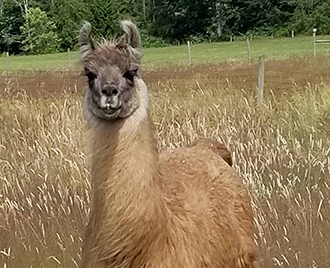This is a recurring column on early-stage research in animals or other laboratory models that has not yet entered the clinic but could have implications for future research and development of human medicines.
Cormac the llama, whose small antibodies suggest the possibility of a preventive measure against COVID-19 infection. Source: National Institutes of Health |
A llama named Cormac and his coronavirus-stopping 'nanobodies'
Early-stage results from the National Institutes of Health have shown that small antibodies from a llama named Cormac could help researchers develop preventive measures against COVID-19 infection.
Researchers from the NIH's National Institute of Neurological Disorders and Stroke isolated tiny antibodies called "nanobodies" from Cormac that were able to cover the spike proteins on the surface of the coronavirus. These spike proteins are the key to the virus's infection process.
The ability of the nanobodies to disable the coronavirus spike proteins suggest that they could be used as a preventive measure or as a diagnostic in patients who are already infected.
To isolate the nanobody from Cormac the llama, the scientists gave the animal five coronavirus immunizations within a month, finding thirteen nanobody candidates that showed a strong reaction.
Additionally, the nanobodies can be used in an inhaled form, which could mean easier administration. The NINDS researchers and neuroscientists T.J. Esparza and David Brody published the study in the journal Scientific Reports and have applied for a patent.
Nanobodies are known to be produced by animals like camels, llamas and alpacas, the NIH said in a Dec. 22 article. They have been studied in the past to recognize proteins on other viruses, bacteria and antigens that cause human disease.
"For years, [we] had been testing out how to use nanobodies to improve brain imaging," David Brody said. "When the pandemic broke, we thought this was a once-in-a-lifetime, all-hands-on-deck situation and joined the fight."
Brody, Esparza and the NIH are further testing the safety and effectiveness of Cormac's nanobody as a preventative treatment or diagnostic for COVID-19.
Expanded primate genome offers human health clues
Researchers at three U.S. universities have compiled a new reference genome for the rhesus macaque monkey that is now the largest genetic database of a primate species and could provide clues to treat human disease.
The scientists from Baylor College of Medicine, the University of Missouri and the University of Washington identified more than 85 million genetic variants in the monkey species, which is the most widely studied nonhuman primate in biomedical research, Baylor said in a Dec. 18 article.
The first rhesus macaque reference genome was assembled in 2007, and the researchers used more advanced technologies to broaden the sequencing of expressed genes.
Rhesus macaques have more genetic variants per individual than humans. Among the mutations were genes that could play a part in human autism and inherited blindness.
"This is a major step forward in the amount of information we have about genetic variation in the rhesus macaque," co-study author Jeffrey Rogers said. "Now colleagues all over the country who are investigating various aspects of health and disease using rhesus macaques can begin to make use of that information."
Gut bacteria's role in Type 2 diabetes
For patients with Type 2 diabetes, an unbalanced composition of the gut microbiome could lead to disease worsening. Scientists at Oregon State University have identified some of those offending bacteria, as well as some that could help treat the disease.
In a study in rats that were fed a Western diet — considered a leading factor in developing Type 2 diabetes — the researchers investigated the specific imbalances, called "dysbiosis," that could affect the disease.
"Some studies suggest dysbiosis is caused by complex changes resulting from interactions of hundreds of different microbes," co-study author Natalia Shulzhenko said. "However, our study and other studies suggest that individual members of the microbial community, altered by diet, might have a significant impact on the host."
Performing the study using a network analysis of host-microbe interactions, the scientists found that two specific bacteria called Lactobacillus johnsonii and Lactobacillus gasseri could improve sugar metabolism in rats with poor diets. Two others called Romboutsia ilealis and Ruminococcus gnavus were found to worsen sugar metabolism.
Comparing these results to previous human studies, the presence of each bacteria corresponded to better or worse body mass indices.
"Our study reveals potential probiotic strains for treatment of Type 2 diabetes and obesity as well as insights into the mechanisms of their action," co-study author Andrey Morgun said. "That means an opportunity to develop targeted therapies rather than attempting to restore 'healthy' microbiota in general."




